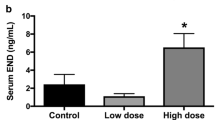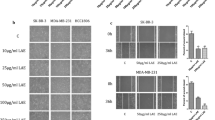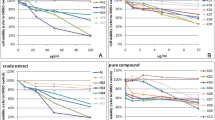Abstract
Flaxseed has been shown to reduce the metastasis of estrogen receptor negative (ER−) human breast cancer in nude mice. This study determined whether enterodiol (ED) and enterolactone (EL), metabolites of plant lignans exceptionally rich in flaxseed, and tamoxifen (TAM), alone or in combination, can influence the various steps of metastasis, that is, breast cancer cell adhesion, invasion and migration, of two ER− human breast cancer cell lines, MDA-MB-435 and MDA-MB-231. The inhibition by ED, EL or TAM (1–5 µM) of cell adhesion to Matrigel or extracellular matrices, fibronectin, laminin, and type IV collagen, as well as cell invasion was dose dependent in both cell lines. When ED, EL and TAM were combined at 1 µM, a greater inhibitory effect on cell adhesion and invasion was observed than with either compound alone. ED and EL at doses of 0.1–10 µM reduced cell migration, but TAM had no effect at 0.1 and 1 µM, and exhibited a stimulatory effect at 10 µM. It is concluded that lignans and TAM, alone or in combination, can inhibit the steps involved in the metastasis cascade. Although more investigations are required, the study also suggests that the intake of the lignan-rich flaxseed may not antagonize the effect of TAM in ER− breast cancer cells.
Similar content being viewed by others
References
Henderson IC, Patek AJ: The relationship between prognostic and predictive factors in the management of breast cancer. Breast Cancer Res Treat 52: 261-288, 1998
Thompson LU: Flaxseed, lignans, and cancer. In: Thompson LU, Cunnane SC (eds) Flaxseed in Human Nutrition. 2nd edn, AOCS Press, Champaign, 2003 (in press)
Thompson LU: Experimental studies on lignans and cancer. Baillieres Clin Endocrinol Metab 12: 691-705, 1998
Chen JM, Stavro PM, Thompson LU: Dietary flaxseed inhibits breast cancer growth and metastasis and downregulates expression of epidermal growth factor receptor and insulin-like growth factor. Nutr Cancer 43: 187-192, 2002
Dabrosin C, Chen J, Wang L, Thompson LU: Flaxseed inhibits metastasis and decreases extracellular vascular endothelial growth factor in human breast cancer xenografts. Cancer Lett 185: 31-37, 2002
Yan L, Yee JA, Li D, McGuire MH, Thompson LU: Dietary flaxseed supplementation and experimental metastasis of melanoma cells in mice. Cancer Lett 124: 181-186, 1998
Li D, Yee JA, Thompson LU, Yan L: Dietary supplementation with secoisolariciresinol diglycoside (SDG) reduces experimental metastasis of melanoma cells in mice. Cancer Lett 142: 91-96, 1999
Forbes JF: The control of breast cancer: the role of tamoxifen. Semin Oncol 24: S1-5-S1-19, 1997
Bliss RD, Kirby JA, Browell DA, Lennard TWJ: Inhibition of endothelial adhesion and invasion by breast carcinoma cells may contribute towards the anti-metastatic effects of tamoxifen. Eur J Surg Oncol 22: 27-33, 1996
Hoelting T, Duh QY, Clark OH, Herfarth C: Tamoxifen antagonizes proliferation and invasion of estrogenic receptornegative metastatic follicular thyroid cells via protein kinase C. Cancer Lett 100: 89-93, 1996
Mathew AC, Rajah TT, Hurt GM, Abidi SMA, Dmtryk JJ, Pento JT: Influence of antiestrogens on the migration of breast cancer cells using an in vitro wound model. Clin Exp Metastasis 15: 393-399, 1997
Gundimeda U, Chen Z-H, Gopalakrishna R: Tamoxifen modulates protein kinase C via oxidative stress in estrogen receptornegative breast cancer cells. J Biol Chem 271: 13504-13524, 1996
Welshons WV, Murphy CS, Koch R, Calaf G, Jordan VC: Stimulation of breast cancer cells in vitro by the environmental estrogen enterolactone and the phytoestrogen equol. Breast Cancer Res Treat 10: 169-175, 1987
Zhang RD, Fidler IJ, Price JE: Relative malignant potential of human breast carcinoma cell lines established from pleural effusions and a brain metastasis. Invasion Metastasis 11: 204-215, 1991
Jiang WG: In vitro models of cancer invasion and metastasis: recent developments. Eur J Surg Oncol 20: 493-499, 1994
Frandsen TL, Boysen BE, Jirus S, Zwiebel J, Spang-Thomsen M, Thompson EW, Brunner N: Assays for the study of human cancer cell invasion and metastasis. Fibrinolysis 6(Suppl 4): 71-76, 1992
Wang AZ, Chen JM, Fisher GW, Wang JC, Diamond HS: Improved in vitro models for assay of rheumatoid synoviocyte chemotaxis. Clin Exp Rheumatol 12: 293-299, 1994
Connolly JM, Rose DP: Effects of fatty acids on invasion through reconstituted basement membrane ('Matrigel') by a human breast cancer cell line. Cancer Lett 75: 137-142, 1993
Thompson LU, Rickard SE, Orcheson LJ, Seidl MM: Flaxseed and its lignan and oil components reduce mammary tumor growth at a late stage of carcinogenesis. Carcinogenesis 17: 1373-1376, 1996
Rickard SE, Yuan YV, Chen J, Thompson LU: Dose effects of flaxseed and its lignan on N-methyl-N-nitrosourea-induced mammary tumorigenesis in rats. Nutr Cancer 35: 50-57, 1999
Pignatelli M, Stamp G: Integrins in tumour development and spread. Cancer Surv 24: 113-127, 1995
Liotta LA, Trygvason K, Garbisa S, Hart I, Foltz CM, Shafie S: Metastatic potential correlates with enzymatic degradation of basement membrane collagen. Nature 284: 67-68, 1980
Rickard SE, Yuan YV, Thompson LU: Plasma insulin-like growth factor I levels in rats are reduced by dietary supplementation of flaxseed or its lignan secoisolariciresinol diglycoside. Cancer Lett 161: 47-55, 2000
Kim H, MullerWJ: The role of the epidermal growth factor receptor family in mammary tumorigenesis and metastasis. Exp Cell Res 253: 78-87, 1999
Yee D: The insulin-like growth factor system as a treatment target in breast cancer. Semin Oncol 29(3) (Suppl 11): 86-95, 2002
Alessandro R, Kohn EC: Signal transduction targets in invasion. Clin Exp Metastasis 19: 265-273, 2002
Akiyama T, Ishida J, Nakagawa S, Ogawara H, Watanabe S, Itoh N, Shibuya M, Fukami Y: Genistein, a specific inhibitor of tyrosine-specific protein kinases. J Biol Chem 262: 5592-5595, 1987
Shao ZM, Wu J, Shen ZZ, Barsky SH: Genistein exerts multiple suppressive effects on human breast carcinoma cells. Cancer Res 58: 4851-4857, 1998
Shao ZM, Wu J, Shen ZZ, Barsky SH: Genistein inhibits both constitutive and EGF-stimulated invasion in ER-negative human breast carcinoma cell lines. Anticancer Res 18: 1435-1439, 1998
Dunn SE, Ehrlich M, Sharp NJ, Reiss K, Solomon G, Hawkins R, Baserga R, Barrett JC: A dominant negative mutant of the insulin-like growth factor-I receptor inhibits the adhesion, invasion, and metastasis of breast cancer. Cancer Res 58: 3353-3361, 1998
Shen F, Xue X, Weber G: Tamoxifen and genistein synergistically down-regulate signal transduction and proliferation in estrogen receptor-negative human breast carcinoma MDA-MB-435 cells. Anticancer Res 59: 1657-1662, 1999
O'Brian CA, Liskamp RM, Solomon DH, Weinstein IB: Inhibition of protein kinase C by tamoxifen. Cancer Res 45: 2462-2465, 1985
Su HD, Mazzei GJ, Vogler WR, Kuo JF: Effect of tamoxifen, a nonsteroidal antiestrogen, on phospholipid/calciumdependent protein kinase and phosphorylation of its endogenous substrate proteins from the rat brain and ovary. Biochem Pharmacol 34: 3649-3653, 1985
Gelmann EP: Tamoxifen treatment of malignancies other than breast and endometrial carcinoma. Semin Oncol 24(1) (Suppl 1): S1-65-S1-70, 1997
Plamontier R, Roberts JD, Glasgow WC, Elling T, Olden K: Regulation of the adhesion of a human carcinoma cell line to type IV collagen and vitronectin: roles for lipoxygenase and protein kinase C. Cancer Res 56: 2206-2212, 1996
Yao J, Xiong S, Klos K, Nguyen N, Grijalva R, Li P, Yu D: Multiple signaling pathways involved in activation of matrix metalloproteinase-9 (MMP-9) by heregulin-beta1 in human breast cancer cells. Oncogene 20: 8066-8074, 2001
Tanos V, Brzezinski A, Drize O, Strauss N, Peretz T: Synergistic inhibitory effects of genistein and tamoxifen on human dysplastic and malignant epithelial breast cells in vitro. Eur J Obstet Gynecol Reprod Biol 102: 188-194, 2002
Furr BJ, Jordan VC: The pharmacology and clinical uses of tamoxifen. Pharmacol Ther 25: 127-205, 1984
Morton MS, Wilcox G, Wahlqvist ML, Griffiths K: Determination of lignans and isoflavonoids in human female plasma following dietary supplementation. J Endocrinol 142: 251-259, 1994
Bashey A, Corringham S, Garrett J, Lane TA, Gilpin EA, Corringham RE, Law P, Ho AD: A phase II study of two cycles of high-dose chemotherapy with autologous stem cell support in patients with metastatic breast cancer who meet eligibility criteria for a single cycle. Bone Marrow Transplant 25: 519-524, 2000
McClay EF, McClay MT, Monroe L, Jones JA, Winski PJ: A phase II study of high dose tamoxifen and weekly cisplatin in patients with metastatic melanoma. Melanoma Res 11: 309-313, 2001
Bergan RC, Reed E, Myers CE, Headlee D, Brawley O, Cho HK, Figg WD, Tompkins A, Linehan WM, Kohler D, Steinberg SM, Blagosklonny MV: A phase II study of highdose tamoxifen in patients with hormone-refractory prostate cancer. Clin Cancer Res 5: 2366-2373, 1999
Author information
Authors and Affiliations
Rights and permissions
About this article
Cite this article
Chen, J., Thompson, L.U. Lignans and Tamoxifen, Alone or in Combination, Reduce Human Breast Cancer Cell Adhesion, Invasion and Migration in vitro . Breast Cancer Res Treat 80, 163–170 (2003). https://doi.org/10.1023/A:1024513815374
Issue Date:
DOI: https://doi.org/10.1023/A:1024513815374




